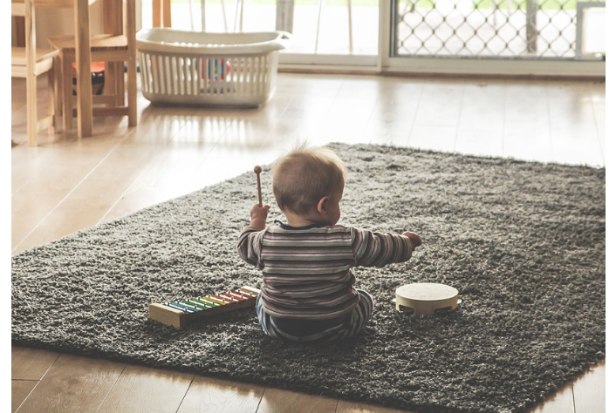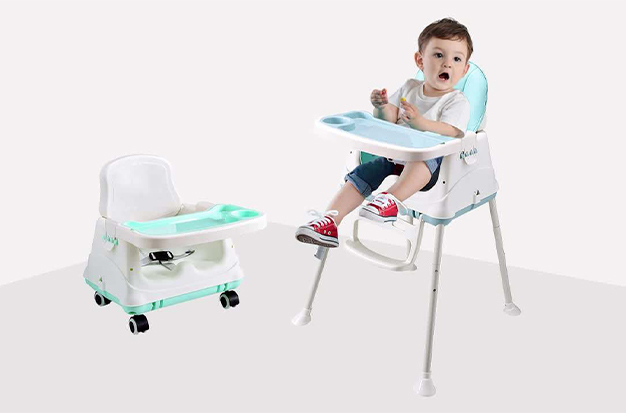With a little assistance getting into position, your baby might be able to sit up as early as six months old. Many infants learn to sit on their own between the ages of 7 and 9 months.
When Do Babies Sit Up?
With a little assistance from a parent, a seat, or by supporting themselves on their hands, most babies are able to sit independently between the ages of 4 and 5 months, though individual babies develop at different rates. When their upper bodies are pulled up to a sitting position, most babies’ heads at this age will sag slightly or not at all.
You can prop your baby up to sit with support starting in the fourth month (or whenever he holds his head up well and seems interested and ready) and give him a stunning new perspective on his surroundings.
Playfully pulling your infant up to sit will aid in the development of neck and head control. Grab baby’s hands and gently pull him up to sit while he is on his back (or possibly your legs). He will enjoy the ride more if he makes amusing faces and loud zooming noises.
When Do Babies Sit Up on Their Own?
Around 6 months of age, when the neck, upper body, and back muscles have fully developed, is when babies can maintain a sitting position unaided, though sometimes they master it earlier or later. There is a wide range of normal, just like with other movements.
Some infants can push themselves up from a lying down position to sit up by the time they are 7 months old, but until about month 11, the majority of infants require assistance from an adult to be pulled up or placed in a sitting position.
Signs Your Baby May Be Ready to Sit
If your infant has good head control, they might be ready to sit. It will also be easier to control and direct other movements of the body.
In addition to pushing themselves up when they are face down when lying face down, babies who are ready to sit up also probably know how to roll over.
If you place your baby upright, they might begin by briefly sitting down. It’s crucial to support your infant at this young age to prevent falls.
Babies who are closer to 7 to 9 months old and approaching the independent sitting milestone are probably able to roll in both directions. Some of them may even be moving back and forth and preparing to crawl. Some individuals might try to push themselves into a tripod position. The infant is supported by one or both hands on the ground while sitting in this position.
Before they can push themselves into a sitting position on their own, it’s likely that your baby will be able to support themselves in the position. With enough repetition, they’ll develop strength and confidence and be expertly sitting up in no time.
What You Can Do to Help Your Baby Sit
By allowing your child to sit upright on their own, you may be able to help them develop the strength needed to sit by themselves. Independent sitting necessitates controlled weight shifts to the left, right, forward, and back. This means that in order to move in all those different directions correctly, it takes a lot of strength and practice.
To help your baby learn to sit up:
- Ensure that your child has a lot of practice making mistakes. Even though you’re nearby, give them space to experiment and explore different strategies and their own physical movements.
- Spending more time on the floor as opposed to putting your child in a seat positioner may help foster this independence. With age-appropriate toys, aim for frequent floor play, preferably twice or three times per day.
- Lay your infant on the floor in between your legs or on your lap. You can read them books, sing songs, and try different movement games, like “timber” onto a soft blanket.
- When they are a little more independent, surround them with pillows or other padding and watch them practice on the ground rather than higher surfaces.
What is the relationship between sitting and doing the tummy?
The foundation for sitting is tummy time. If your child doesn’t enjoy playing on their stomach for extended periods of time, start with a few minutes, several times per day. A clean diaper and good sleep for your infant are a must. Achieve eye level with your child by rolling over onto your stomach as well. Your baby may hold the position longer if they can see your face. You might also try placing a soft mirror on the ground so that your child can see their own face. Tummy time mirrors are available online and in most baby supply stores.
You can gradually extend the time as they get used to being in this position.

Can My Baby Safely Use a Baby Seat?
You have probably seen a variety of baby seats on the market. The Bumbo Seat, for instance, is a well-liked option among parents and is suitable for infants from 3 to 9 months old, or as soon as the child can hold up their head. It is made from a molded material that conforms to your baby’s body to support sitting.
Children’s skill development may be hampered when they are seated for extended periods of time or too early, according to pediatric physical therapist Rebecca Talmud. In other words, while your baby may be sitting up straight, they aren’t developing the crucial trunk and head control that will best develop when they are practicing new body movements independently.
To use a baby seat, you might want to hold off until your child is almost at the sitting milestone. Consider waiting until your baby is between 6 and 8 months old before propping him or her up. Additionally, don’t use this seat as the only training aid for the infant.
Sitting Safety
If your baby is still learning how to sit upright, you might want to sit with them tucked between your legs so that you can provide them with support from all sides. Pillows work well as props as well, but when your baby is propped up, keep an eye on them.
Sitting is a sign that you might want to baby-proof your home in anticipation of more mobility, even though your baby may not be cruising around just yet.
- In every room your baby frequently visits, use outlet covers.
- As necessary, secure other things or spaces. In most big box and hardware stores, you can find items like cabinet locks, toilet locks, furniture anchors, baby gates, and other baby-proofing supplies.
- Away from the baby’s reach, keep any objects that could choking him or her, be poisonous, or otherwise dangerous. Getting down on the ground at your baby’s level may even be helpful to check for dangers.
- Once the infant is seated, lower the mattress in the crib. This milestone will soon be followed by pulling up, and babies practice their motor skills throughout the day, even when they should be sleeping.
- High chairs and other seating apparatus should have safety belts. It takes a lot of strength to sit by yourself. When sitting for longer periods of time, your baby may require the additional support provided by the straps. Additionally, avoid setting up seats in or close to water or on elevated surfaces.
What Should You Do If You Suspect a Developmental Delay?
Contact your pediatrician if your child isn’t able to sit up on their own by nine months of age. It might be best to take action sooner, particularly if your child is almost 9 months old and unable to sit upright. While each baby’s development is unique, this could point to a delay in the development of gross motor skills.
Other possible signs of motor delay include:
- stiff or tight muscles
- floppy movements
- only reaches with one hand over another
- does not have strong head control
- does not reach or bring objects to mouth
If you think your child might have a delay, assistance is available. Speak with your doctor or nurse first. They might recommend infant and young child services like the public early intervention program run by your state.
How Can I Encourage My Baby to Sit Up from Lying Down?
Your child may fall over a few times as they practice sitting because it takes practice.
By knowing what your baby is capable of and what signs to look for, you can encourage your baby to sit up by doing the following:
1. Provide Support
The most effective way to accomplish this is by supporting them with a toy nearby in the corner of a sofa or in between your legs.
Your baby can practice the tripod sit in this position by extending a hand to support themselves and push themselves back up into the sitting position.
2. Stay Close and Create a Soft Landing Place
When your baby is learning to sit, even if they are well supported, you MUST watch over them constantly. Also, make sure they have a soft place to fall by placing pillows or cushions all around them.
If they fall unexpectedly, babies are prone to becoming frightened, which can impede their ability to sit independently and eventually learn to sit up from lying down.
3. Place Toys for Reaching
Toys should be placed initially within easy reach of your child, then gradually moved a little further away and to the sides to encourage them to turn from side to side.
4. Don’t Stop Tummy Time
Tummy time CANNOT be reduced just because your child is progressing toward independent sitting.
Spending time on a baby’s stomach is still crucial because it will aid in crawling and the ability to transition from lying on their front to sitting.
5. Have Time on Their Backs Too
Additionally, it’s important for them to spend time on their backs, particularly when doing so under play gyms where they have to reach for dangly toys. In order to help the baby sit up from lying down, it is essential that their upper body and arms be strong.
6. Use a Support Or Boppy Pillow When They’re Ready
Make sure your baby is developmentally prepared to use a support or Boppy Pillow before using one.
When a baby is not yet ready, it is not good for their development to place them in a sitting position for extended periods of time.
However, these support seats can be ideal for practicing sitting once they have the strength.
What Muscles Need to Be Developed for Baby to Sit Up from Lying Down?
To be able to sit up from a lying down position, a baby’s muscles primarily need to develop in these areas.
- Neck
- Shoulders
- Spinal column
- Chest
- Arms
How Does Lying on Their Back Or Front Affect a Baby Learning to Sit Up?
Both laying your baby on their back and their front are significant activities to include in baby’s day.
By building up the neck, shoulder, upper body, chest, and arm muscles—all of which must be strong for your child to sit independently—these positions assist babies in learning to sit independently.
Additionally, they need these muscles to be able to support themselves when they want to stand up from a lying down position or recline from a sitting position.
When Do Babies Sit Up and Crawl?
Your child will gain the upper body strength he’ll need to begin crawling, which typically occurs around the 9-month mark, with plenty of practice sitting upright (plus tummy time). While some infants start to crawl as early as 6 months, others delay it or never start.
You can encourage your baby to begin his first crawling movements by teaching him to sit up. In fact, babies often “discover” crawling from learning to sit. He may discover if he leans over while sitting that he can rock back and forth and, eventually, advance inch by inch if he does so. To your baby’s first literal steps, sitting is merely another (figurative) step.
When to See a Doctor
There are no set rules for when a baby will reach particular milestones, as there are with everything related to their development.
However, by the time they are 6 months old, the majority of infants will have mastered sitting, and by the time they are 9 months old, they will be able to sit up from lying down.
You should speak with a doctor to identify or rule out any gross motor skill delays if your baby is not demonstrating independent sitting behavior by this age.
How to Teach Baby to Sit Up from Lying Down Recap
When it comes to determining when babies sit up from lying down, you need to lay the groundwork for the baby to learn to sit confidently FIRST.
It’s crucial to make sure your baby participates in the fundamental activities of tummy time, lying on their back, and rolling over because doing so will help prepare their muscles and balance for sitting long before they are able to do so on their own.
Once their muscles are sufficiently developed, you can progress to supporting them while you assist them in learning to maintain their balance while sitting while still allowing your muscles to continue to grow.
FAQs
Reasons Why Baby Can’t Sit Up
Independent sitting won’t happen until they have proper head control. It takes time for a baby’s neck muscles to develop; for the majority, this will have happened by the time they are 6 months old. Your baby’s neck and head muscles start rapidly strengthening around the 4-month mark.
Why 8-Month-Old Baby Can’t Sit Up from Lying Down
If your baby isn’t sitting on their own by age nine months, contact your pediatrician. It might be best to take action sooner, particularly if your child is almost 9 months old and unable to sit upright. Although each baby’s development is unique, this could indicate a delay in the development of gross motor skills.



